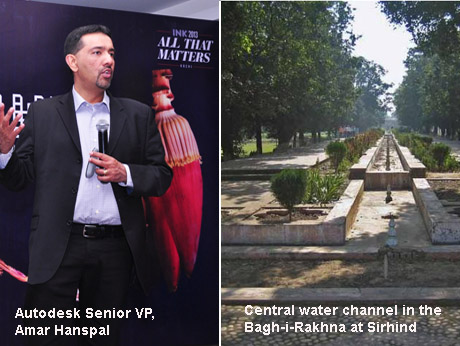
Kochi, October 25, 2013:CAD software leader Autodesk unveiled the company's efforts -- along with UNESCO -- to capture 3-D imagery of the world's heritage sites. In a talk today at the INK Conference, Autodesk Senior Vice President, Amar Hanspal showcased showcased several local examples of what is achievable with ReCap – from a 3D capture of a small Krishna statue to a 3D capture of the enormous hammam at one of the oldest Mughal gardens in India (the 16th century complex Aam Khas Bagh aka Bagh-i-Rakhna at Sirhind in Punjab).
He said: , “Today, our reality capture tools can also help protect the past. “Autodesk is in discussions with UNESCO to make a broader technology gift to support heritage conservation. We are particularly interested in helping India, which has one of the world’s richest collections of World Heritage sites, such as the Ajanta Caves, the monuments at Sanchi, Taj Mahal, Red Fort and Himalayan Railways. Also, there are hundreds more that could benefit from increased conservation, from basic documentation to the creation of 3D digital models that enable analysis and interpretation."
Autodesk ReCap is a family of software and services to create intelligent 3D data from captured photos and laser scans. ReCap makes it easy to clean, organize and visualize massive datasets captured from reality.
He added that Autodesk’s reality capture technology is helping conserve, preserve and educate on cultural heritage around the world:
· Smithsonian X 3D: Autodesk is supporting this project, which shows how 3D technologies will transform the work of the Smithsonian Institution and museum and research institutions worldwide. For the first time ever, state-of-the-art 3D scanning and image-based modeling technology paired with new Smithsonian technology will enable museum collections, scientific specimens, and entire research sites to be digitally recorded, studied, and shared in immersive detail.
· Paleontologist Louise Leakey: The Leakey family’s work has been critical to establishing human evolutionary development in Africa. Louise used Autodesk 123D Catch software in Kenya to capture rare, million-year old hominid skulls in a textured 3D model to share with the world.
· Bamiyan Buddhas: After the Taliban bombed the Bamiyan Buddhas, there was no known record of the Buddhas. Autodesk piloted a project to create a digital record. This included crowd-sourcing tourists’ publicly posted online photos. Autodesk used photogrammetry techniques to create an accurate 3D digital model for the world to enjoy.